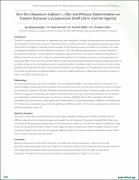| dc.description.abstract | Introduction - Tomato (Lycopersicon solanum) is a vegetable crop which belongs to a family Solanaceae and is dicotyledonous
plant.Despite its nutritional, economic, and health value, tomato production is hampered by post-harvest losses,
which limit the longevity of storage and the number of high-quality products available to customers. This study
investigated the effect of sim-sim (Sesamum indicum L.) bio-ash efficacy determination on tomato (Solanum
lycopersicum) shelf life in central Uganda. The specific objectives of the study were: to determine the effect of
different rates of sim-sim ash on decay incidence and weight loss of tomatoes stored at room temperature, to
assess the effect of sim-sim ash and their effect on textural characteristics (hardness, softness soggy and spoilt) of
tomatoes stored at room temperature and to examine the effect of different rates of sim-sim ash on the sensory
attributes (half ripe and full ripe) for the tomatoes stored at room temperature. An experiment was conducted at
the Faculty of Agriculture of Uganda Martyrs University in Nkozi Sub County, Mpigi district during the months of
March-July 2022 cropping season. A
Methodology - An experimental design used was completely randomized design (CRD) in the study with four treatments. The
factors studied included 0.5kg (P2), 1.0kg (P3) and 1.5kg (P4) of sim-sim bio-ash and control (P1) in which tomatoes
were stored for a period of 55 days. Different parameters were assessed, decay incidence, weight loss, hardness,
softness, sogginess of tomatoes and number of spoilt tomatoes, half ripe and full ripe tomatoes .Data collected
was subjected to statistical technique of analysis of variance (ANOVA) at (P<0.05) to ascertain the Fishers
probability (Fpr), grand mean, Least signifi-cance differences (L.S.D and percentage co-efficient of variations (%
CV). Means were compared using the least significance difference best (L.S.D) and was analysed using Genstat a
statistical package version 14.
Results & Discussion - The results of the study indicated that there were highly significant differences (P<0.001) recorded with the
different rates of sim-sim bio ash on decay and weight loss of tomatoes, The results indicated that 1,5kg of sim
sim ash gave the lowest percentage decay of 79% and lowest weight loss. Further the results revealed that 1.5kg
of sim sim ash gave the lowest number of soft, soggy and spoilt tomatoes but with the highest number of hard
tomatoes. Finally 1.5kg of sim sim ash gave the highest number of full ripe tomatoes and lowest number of half
ripe tomatoes during the storage period.
Conclusion - Basing on the results of the study ,It was also concluded that storing tomatoes in 1.5kg of sim-sim ash
gave the lowest percentage decay and weight loss, increased number of hard tomatoes and reduced number of
soft, soggy, spoilt tomatoes as well as increasing tomato ripening faster than the other counter parts
treatments. Therefore farmers are recommended to store tomatoes in 1.5kg of sim-sim ash. | en_US |


